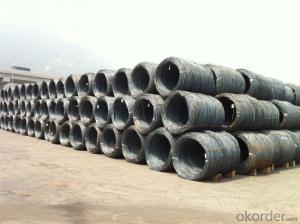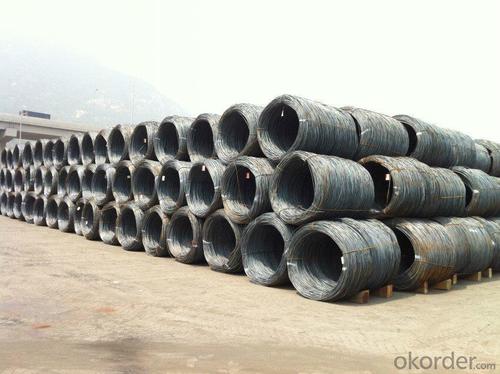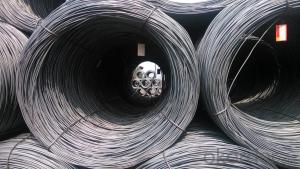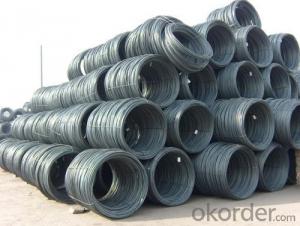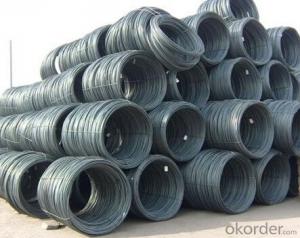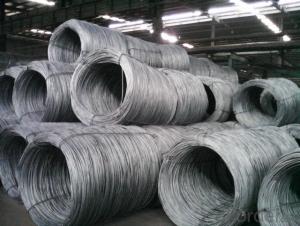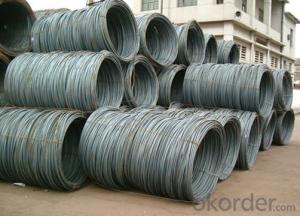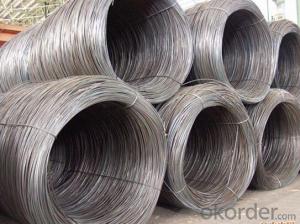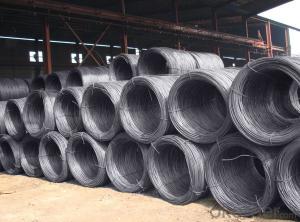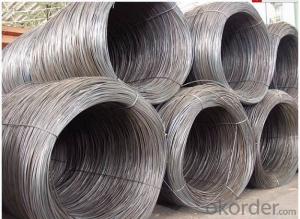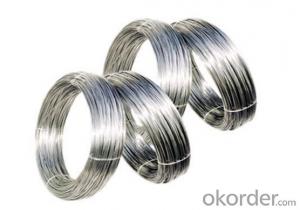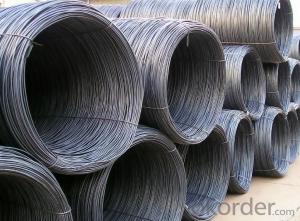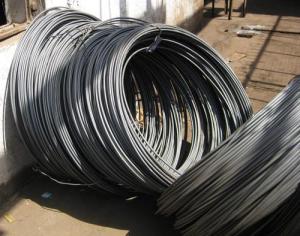SAE1008 Wire Rod ,5.5mm steel wire rod,hot rolled Wire Rod for sale
- Loading Port:
- Tianjin
- Payment Terms:
- TT OR LC
- Min Order Qty:
- 50 m.t.
- Supply Capability:
- 5000 m.t./month
OKorder Service Pledge
OKorder Financial Service
You Might Also Like
Specification
Specifications of Steel Wire Rod in Coil:
Steel Grade: Q195/235, SAE1006-1018B Standard: ASTM, GB
Diameter: 5.5mm, 6.5mm, 7mm,8mm,9mm,10mm,12mm,14mm
Type: Drawn Wire Alloy or Not: Alloy Brand Name: HSKY
Technique: Hot Rolled Place of Origin: China Mainland
Chemical Composition:(Please kindly find our chemistry of our material based on SAE1006B and SAE1008B as below for your information)
High carbon/Low carbon/common carbon Steel wire rod | With boron for rebate tax |
Grade | SAE1006B SAE1008B SAE1018B |
Package | In coil ,in bundle, |
Coil weight | about 2000kg-3000kgs |
Size: | 5.5mm 6.5mm 8mm 10mm 12mm 14mm 16mm |
Types | High Carbon ,Low carbon ,Common carbon |
Exported Country | South Korea,Vietnam,Indonesia,Myanmar,Philippines and Afrca,Ect |
Delivery term: | within 30 days after receive the LC |
Payment Term: | LC at sight ,LC 30-120 days after B/L date, TT payment |
The Standard of Physical Properties:
Grade | Chemical Composition(%) | |||||
C | Mn | Si | S | P | Cr | |
SAE1006 | 0.03~O.07 | ≤0.32 | ≤0.30 | ≤0.045 | ≤0.040 | >0.30 |
Mechanical properties | ||||||
Yield strength(N/mm2) | Tensile strength(N/mm2) | Elongation(%) | ||||
250-280 | 350-380 | ≥32 | ||||
Grade | Chemical Composition(%) | |||||
C | Mn | Si | S | P | Cr | |
SAE1008 | 0.10max | 0.3~O.50 | 0.15max | 0.050max | 0.040 max | 0.30 min |
Mechanical properties | ||||||
Yield strength(N/mm2) | Tensile strength(N/mm2) | Elongation(%) | ||||
≥195 | 315-430 | ≥30 | ||||
Usage and Applications of Steel Wire Rod in Coil:
After hot-rolled the products shaped into coil and delivery as finished product, including round, square, rectangular, hexagonal and so on, Since most of the products are round, it is generally called wire rod. Steel wire rod is widely used in construction and manufacturing. Steel wire rod is mainly used for reinforcement of reinforced concrete and welded structure or reprocessed (roberts, nail etc) materials, especially used to produce wire drawing, welding electrode, nails,spring, electronic, precise machinery parts and so on.
Packaging & Delivery of Steel Wire Rod in Coil:
Packaging Detail: products are packed in coil and then shipped by container or bulk vessel
Each coil weight: 2-3MT
Delivery Detail: within 45 days after received deposit or LC.
Label: to be specified by customer, generally, each bundle has 1-2 labels
Trade terms: CFR, CIF
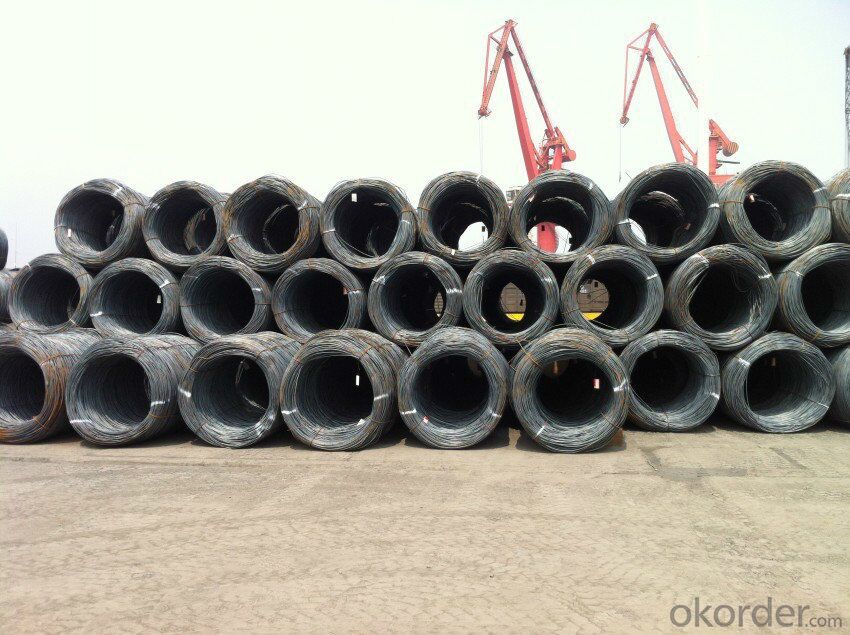
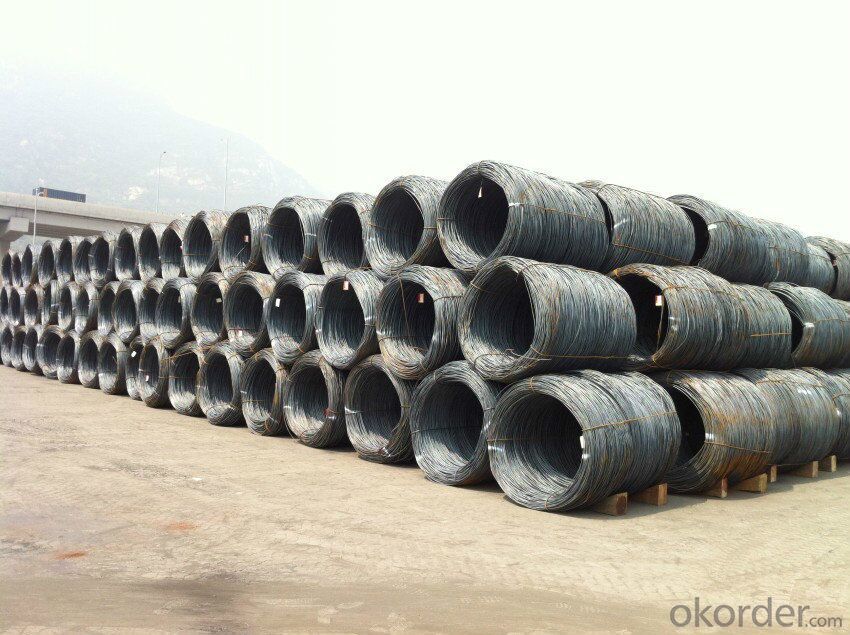
- Q: What are the different types of coatings for steel wire rod?
- Steel wire rods can be enhanced and safeguarded from corrosion through the application of various coatings. Some commonly employed coatings are as follows: 1. Zinc Coating: Galvanization, also known as zinc coating, is a highly favored option for steel wire rods. It ensures exceptional resistance against corrosion and can be applied using hot-dip galvanization or electroplating techniques. 2. Polymer Coating: Polymer coatings are often utilized to provide extra protection against corrosion and abrasion. These coatings can be applied through dip coating, extrusion, or powder coating methods, offering commendable adhesion and flexibility. 3. Phosphate Coating: Phosphate coatings are commonly employed as a pre-treatment for steel wire rods before the application of other coatings. They enhance the adhesion of subsequent coatings and improve corrosion resistance. 4. Epoxy Coating: Epoxy coatings are renowned for their exceptional adhesion and chemical resistance. They find frequent usage in industrial settings where the wire rods are exposed to harsh environments or corrosive substances. 5. Powder Coating: Powder coatings provide a robust and aesthetically pleasing finish to steel wire rods. These coatings are applied as dry powder and then cured under heat to create a smooth and protective layer. 6. Organic Coating: Organic coatings, such as acrylics or polyurethanes, are often employed for aesthetic purposes or to impart a specific color to the wire rods. These coatings also offer a certain degree of corrosion protection. 7. Ceramic Coating: Ceramic coatings find their application in high-temperature scenarios where the wire rods are subjected to extreme heat or thermal cycling. They exhibit excellent heat resistance and can withstand thermal shocks. It is crucial to select the appropriate coating based on the specific requirements and intended use of the steel wire rods. Different coatings provide varying levels of protection, durability, and resistance to specific environmental factors.
- Q: What are the different types of steel wire rod coatings used for increased adhesion?
- There are several types of steel wire rod coatings that are commonly used to enhance adhesion. These coatings are applied to the surface of the wire rod to improve its ability to bond with other materials. One of the most commonly used coatings is zinc coating, also known as galvanizing. This involves immersing the wire rod in a bath of molten zinc, which forms a protective layer on the surface of the steel. Zinc coating not only enhances adhesion but also provides corrosion resistance, making it suitable for outdoor applications. Another popular coating is copper coating. This involves electroplating the wire rod with a layer of copper, which enhances adhesion and improves conductivity. Copper coating is often used in electrical applications where a strong and reliable bond is required. Phosphate coating is another type of coating used for increased adhesion. This involves treating the wire rod with a solution containing phosphoric acid and other chemicals, which create a thin layer of phosphate crystals on the surface. Phosphate coating improves adhesion by providing a roughened surface for better bonding. Polymer coating is also used to enhance adhesion in certain applications. This involves applying a layer of polymer material, such as polyethylene or polyvinyl chloride (PVC), to the wire rod. Polymer coatings provide a strong bond with other materials and can also provide additional benefits such as insulation or protection against chemicals. In summary, the different types of steel wire rod coatings used for increased adhesion include zinc coating, copper coating, phosphate coating, and polymer coating. Each of these coatings has its own unique properties and is suitable for specific applications where improved adhesion is required.
- Q: How is steel wire rod used in the manufacturing of wire for underground cable systems?
- Steel wire rod is a crucial component in the manufacturing process of wire used in underground cable systems. The steel wire rod serves as the primary raw material that is transformed into the final wire product. The production process begins with the steel wire rod being subjected to various mechanical and heat treatments to enhance its strength and durability. Once the steel wire rod has been processed, it is then drawn through a series of dies to reduce its diameter and increase its length. This drawing process helps to refine the wire's mechanical properties, such as its tensile strength and flexibility, making it suitable for underground cable applications. The drawn steel wire is then further processed to ensure it meets the specific requirements for underground cable systems. This may involve applying a protective coating, such as zinc or polymer, to enhance corrosion resistance and insulation properties. Additionally, the wire may undergo further heat treatment processes, such as annealing, to relieve internal stresses and improve its overall performance. Finally, the finished wire is wound onto spools or reels, ready to be used in the manufacturing of underground cable systems. The wire is typically combined with other components, such as insulation materials and protective layers, to form a complete cable assembly. These cables are then installed underground to facilitate the transmission of electricity, telecommunications signals, or data. Overall, steel wire rod plays a vital role in the manufacturing process of wire for underground cable systems. It provides the necessary strength, flexibility, and durability required for these cables to withstand the harsh underground environments while ensuring efficient transmission of power or information.
- Q: How is steel wire rod used in the manufacturing of nails?
- Steel wire rod is an essential raw material used in the manufacturing of nails. It is first drawn through a series of dies to decrease its diameter and increase its length, resulting in a thinner and longer wire. This wire is then cut into appropriate lengths and fed into a nail-making machine. The machine forms the wire into the shape of a nail, cuts the nail to the desired length, and adds a head or point if necessary. Steel wire rod provides the strength and durability required for nails to hold materials together securely.
- Q: What are the disadvantages of using steel wire rod in manufacturing?
- One of the main disadvantages of using steel wire rod in manufacturing is its susceptibility to corrosion. Steel wire rod can rust if exposed to moisture or certain chemicals, which can weaken its structural integrity and shorten its lifespan. Additionally, steel wire rod may be heavy and difficult to handle, making it more challenging to work with during the manufacturing process. Finally, steel wire rod may have limited flexibility compared to other materials, which can limit its suitability for certain applications where flexibility is required.
- Q: How is steel wire rod used in the manufacturing of wire forms for automotive seat belts?
- Steel wire rod is used in the manufacturing of wire forms for automotive seat belts as it serves as the primary raw material. The steel wire rod is first drawn into a thinner wire and then formed into various shapes and sizes to create the necessary components of the seat belts, such as buckles, connectors, and retractors. This high-strength material ensures the seat belts can withstand the necessary forces and provide the required safety for passengers in vehicles.
- Q: How is steel wire rod cooled after the rolling process?
- Steel wire rod is typically cooled after the rolling process using a water cooling system. The hot wire rod is passed through a series of water sprays or immersion tanks, which rapidly cool the rod to a desired temperature. This quick cooling helps to enhance the mechanical properties and ensure uniformity in the wire rod's structure.
- Q: How is steel wire rod used in the production of wire baskets?
- Steel wire rod is used in the production of wire baskets as it serves as the primary raw material for manufacturing the wire mesh used in the baskets. The steel wire rod is processed and transformed into wires of various thicknesses and lengths, which are then woven or welded together to create the mesh structure of the basket. This ensures the strength, durability, and stability of the wire basket, making it suitable for holding and organizing various items.
- Q: How is steel wire rod used in the manufacturing of wire forms for HVAC systems?
- Steel wire rod is used in the manufacturing of wire forms for HVAC systems as it provides the necessary strength and durability required for these applications. It is commonly used to create various wire components such as springs, clips, hooks, and brackets, which are integral parts of HVAC systems. By using steel wire rod, manufacturers can ensure that the wire forms are able to withstand high temperatures, resist corrosion, and provide sufficient support and stability to the overall HVAC system.
- Q: What are the common applications of hot rolled steel wire rod?
- Hot rolled steel wire rod, known for its versatility and strength, finds extensive use in various industries. It is employed in a multitude of applications, including: 1. Construction: The construction industry heavily relies on hot rolled steel wire rod for diverse purposes. It is commonly employed in the production of concrete reinforcement bars (rebars) that enhance the strength and durability of buildings, bridges, and other infrastructure projects. Moreover, it is utilized in the manufacturing of fences, nails, and wire mesh, all of which are vital components in construction. 2. Automotive industry: The automotive sector widely utilizes hot rolled steel wire rod in the production of parts and components. It is instrumental in the manufacturing of suspension systems, engine components, steering mechanisms, and various other automotive parts that require exceptional strength and resilience. 3. Industrial machinery: Hot rolled steel wire rod is an indispensable material in the production of industrial machinery. It is employed in the manufacturing of gears, shafts, bearings, and other components that necessitate high strength, toughness, and resistance to wear and tear. 4. Wire products: A wide array of wire products heavily relies on hot rolled steel wire rod. It is employed in the manufacturing of wire ropes, springs, cables, and other wire-based products that are subjected to heavy loads and require reliability and durability. 5. Welding electrodes: The production of welding electrodes also involves the use of hot rolled steel wire rod. These electrodes find application in various industries for welding and joining different types of metals. The outstanding strength and ductility of hot rolled steel wire rod make it an ideal material for manufacturing welding electrodes. 6. Fasteners: Hot rolled steel wire rod is utilized in the production of diverse fasteners, including bolts, screws, and nuts. These fasteners are widely employed in industries such as construction, automotive, and manufacturing, where robust and dependable connections are crucial. In conclusion, the applications of hot rolled steel wire rod span across a broad range of industries, encompassing construction, automotive, machinery, wire products, welding, and fasteners. Its exceptional strength, versatility, and durability render it an indispensable material in numerous manufacturing processes.
Send your message to us
SAE1008 Wire Rod ,5.5mm steel wire rod,hot rolled Wire Rod for sale
- Loading Port:
- Tianjin
- Payment Terms:
- TT OR LC
- Min Order Qty:
- 50 m.t.
- Supply Capability:
- 5000 m.t./month
OKorder Service Pledge
OKorder Financial Service
Similar products
Hot products
Hot Searches
Related keywords
